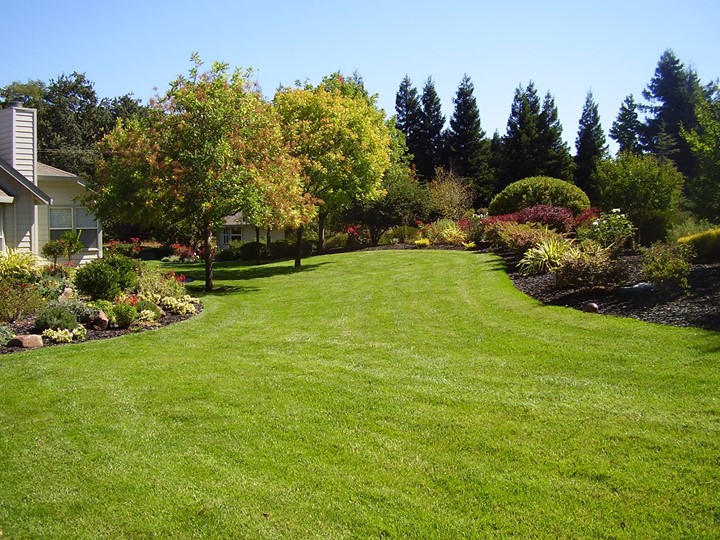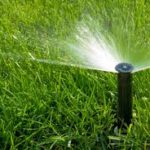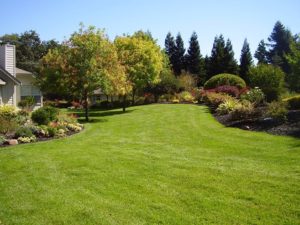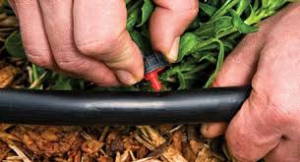Rhizomatous Tall Fescue (RTF) Guide
ESTABLISHMENT (Phase 1) – NEWLY INSTALLED SOD (Weeks 1-4)
Fertilizer Instructions: Spread Starter Fertilizer before the sod is Installed. If you do not have starter fertilizer at the
time of installation, you can still apply it afterwards.
Water Instructions: As soon as your sod is installed, thoroughly water it. The first watering is the most critical and will prevent problems later. Then water 2-3 times a day for the first 4 weeks. Watering in a way that keeps the soil moist continuously, which means water light and frequent. Increase water in any areas that show stress, but do not allow water to form puddles.
Mowing Instructions: Mow as soon as it is tall enough to mow. After that you can mow at 2 ½” – 3” high. DO NOT mow if the ground is saturated and doing so will leave tracks or footprints. You should never mow off more than 1/3 of the total height of the grass.
ESTABLISHMENT (Phase 2) – (Weeks 5-11)
Fertilizer Instructions: Use Grow-In Fertilizer after 6 weeks of installed date. After that you will begin the Maintenance Program.
Water Instructions: 1 ½” – 2” every other week, or more frequently if wilting. Water instructions based on no rain, wind, excessive heat and/or drought. Also, do not let the grasses wilt in the establishment phases. If wilting occurs then more watering is necessary.
Mowing Instructions: 2” – 3” high. You should never mow off more than 1/3 of the total height of the grass.
MAINTENANCE – (Weeks 12+)
Fertilizer Instructions: See Back under Fertilizer Guide
Water Instructions: 1 ½” – 2” every other week, or more freq. if wilting occurs. Water instructions based on no rain, wind, excessive heat and/or drought. Also, do not let the grasses wilt in the establishment phases. If wilting occurs then more watering is necessary.
Mowing Instructions: 2” – 3” high. You should never mow off more than 1/3 of the total height of the grass.
Fertilizer Guide
Below you will find the suggested fertilizer applications for the RTF Sod. Because of soil type variations, we strongly suggest you contact your local RTF Sod supplier for the fertilizer analysis (N-P-K) that is desirable in your area. For instance; in the Midwest the desirable Starter Fertilizer could range from 10-10-10 to 18-24-12, depending on the soil in your specific area and what nutrients are either missing or over-abundant.
Establishment – Phase 1 (Newly Installed Sod – Week 1)
STARTER FERTILIZER – For use at time of installation – preferably before the sod is installed, but you can apply afterwards if necessary. This fertilizer helps to stabilize the sod and begins blade and root development. In the summer months when burning or leaching may be a concern, you can use an Organic Starter Fertilizer. The Starter Fertilizer will last for 6 weeks.
Establishment – Phase 2 (Week 6)
GROW-IN FERTILIZER – Use after the first 6 weeks have passed since the new sod was installed and the Starter Fertilizer had been applied. Once you spread the Grow-In Fertilizer it will last for 6 weeks. This helps with root development and overall vigor.
Maintenance Program – 4 Step Lawn Fertilization Program (Week 12+)
PRE-EMERGENT FERTILIZER – For crabgrass and weed control. It can be applied in early April to mid-May.
POST-EMERGENT FERTILIZER – For broadleaf control. It can be applied mid-May to late June.
GRUB CONTROL FERTILIZER – For grub prevention and control. It can be applied late June to early August.
WINTERIZER FERTILIZER – Helps prepare your lawn for the winter. It can be applied mid-Sept to late Nov.
VERY IMPORTANT INFORMATION:
~ Depending on application timing, allow a minimum of 6 weeks between applications.
~ Starter and Grow-In Fertilizer are very important to the success of your new lawn in the first 3 months. From then on, depending where you fall on the calendar year, follow a normal fertilizer maintenance program.
~ You can use Pre-Emergent, Post-Emergent, and Grub Control with the Starter or Grow-in fertilizers IF weeds or insects are a concern.
~ These are general guidelines to follow. Weather conditions would influence how closely to follow these steps. You may consider using an organic Starter Fertilizer in the summer months as well.
TURF TIPS:
1. When watering, use a rain gauge or some container with straight sides (like a tuna can) to measure your sprinkler’s output. A common mistake is overestimating the amount of water being supplied by your sprinkler, so measure to be sure.
2. Avoid watering in the evening. Water early in the morning, especially during the summer.
3. Make sure your new lawn (first 4 weeks) has enough moisture to survive hot, dry or windy days.
4. Depending on weather conditions you can adjust how many times you water and how much.
5. Do not ‘drown’ your lawn. If you do, you will have a lawn with a shallow root system that is susceptible to grubs and heat/drought stress. Never allow water to puddle on top of the sod.
6. Make sure you do not have heavy traffic (kids and/or pets) on your new lawn for the first 4 weeks.
7. Make sure your lawnmower has sharp blades.
8. Mow at a consistent height year-round between 2”-3”.
9. DO NOT mow if ground is saturated and doing so will leave tracks or footprints.
10. You should never mow off more than 1/3 of the total height of the grass.
11. Leave the grass clippings on the lawn as they will add fertilizer to the turf and enrich your soil.








